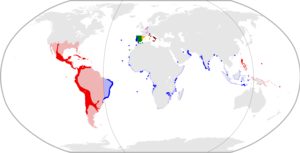Consejo Supremo de Italia
The Consejo Supremo de Italia , or Consejo de Italia for short, was an institution that was supposed to advise the Spanish kings regarding the rulers in Italy and to prepare decisions for the king. The Consejo were also a collegial authority that carried out government and administrative tasks independently. The Consejo de Italia was created in 1556 by King Philip II of Spain and built up in several stages until 1559.

Predecessor institutions
King Alfonso III von Aragón set up an advisory body (Consejo Real) on a case-by-case basis, which made suggestions on the upcoming government decisions. Under Peter IV the Consejo became a permanent institution of the royal government. He also set up a State Chancellery (Cancillería real aragonesa) and made its head chairman of the Consejos. By royal decree of November 19, 1494, Ferdinand II united the Consejo Real of the Crown of Aragón and the Cancillerías in one authority that was primarily staffed by lawyers. This Consejo de Aragón, which was created in this way, was one of the Consejos that dealt with the respective government affairs of the Catholic Kings. B. Consejo de Indias , Consejo de Castilla, Consejo de la Suprema y General Inquisición.
After Ferdinand regained control of Naples , he set up his own Consejo for Naples in 1505. He refused a jurisdiction of the Consejos de Aragón, since the victory over the French troops in Italy had been achieved by means and military who came from Castile. The members of the new Consejo were, however, lawyers from the Consejo de Aragon so that there was a close relationship between the two institutions. After his return from Italy Ferdinand did not dissolve the Consejo but he continued to work under the name “Auditorio del Rey”. In the course of his reign, King Charles I restricted the powers of the Consejo de Aragon so that the focus of the Consejo's work lay on the legal system and advising the king and less on direct administration.
With regard to Milan , the Senate of Milan can be seen as the predecessor institution. The establishment was by Louis XII. Founded by France to combine judicial and administrative tasks on the model of the French parliament. The initial 15 members belonged to the Lombard aristocracy. By replacing some of these members and adding lawyers to their number, Charles V transformed the Senate into a legally adept authority.
Reason for the creation of the Consejo de Italia
The creation of the Consejo de Italia by Philip II happened as part of a general restructuring of the administration of the territories that the king had taken over from his father. These domains were not identical to the domains of the Catholic Kings , so that it made no sense to fall back on old structures. One reason for the creation of a Consejo to deal only with Italian affairs were problems that had arisen in the Consejo de Aragón in considering and protecting the very different local prerogatives of the territories of the Crown of Aragón.
Jurisdiction
The Consejo de Italia was locally responsible for “both Sicilies” that is the island and the Kingdom of Naples on the mainland, as well as for the Duchy of Milan. The island of Sardinia , which today belongs to Italy, was still within the scope of the Consejo de Aragón. The content-related responsibilities changed again and again over time. Basically, the Consejo was concerned with general government decisions, the jurisprudence, the economy, the property and finances of the crown and the state such as duties and tithe and the appointment of holders of civil and military offices.
composition
In accordance with the task of the Consejo to advise the king on questions of local law, which at that time hardly existed as codified law , and the traditional procedures, half of the Consejo was usually made up of lawyers from the territories on whom advice was to be given. The Consejo de Italia thus consisted of a chairman and two members each for Milan, Naples and Sicily.
Individual evidence
- ↑ María del Pilar Mesa Coronado: El Virreinato de Sicilia en la Monarquía Hispánica. (PDF) las instituciones de gobierno (1665–1675). In: Estudios humanísticos. Historia, ISSN 1696-0300 , Nº. 12, 2013. 2013, p. 164 , accessed January 17, 2015 (Spanish).
- ↑ Manuel Rivero Rodríguez: El consejo de Aragón y la fundación del Consejo de Italia. (PDF) In: Pedralbes: Revista d'historia moderna, ISSN 0211-9587 , Nº 9, 1989. 1989, p. 65 ff. , Accessed on January 18, 2015 (Spanish).
- ↑ Manuel Rivero Rodríguez: El consejo de Aragón y la fundación del Consejo de Italia. (PDF) In: Pedralbes: Revista d'historia moderna, ISSN 0211-9587 , Nº 9, 1989. 1989, p. 68 , accessed on January 18, 2015 (Spanish).
- ↑ Manuel Rivero Rodríguez: El consejo de Aragón y la fundación del Consejo de Italia. (PDF) In: Pedralbes: Revista d'historia moderna, ISSN 0211-9587 , Nº 9, 1989. 1989, p. 79 , accessed on January 18, 2015 (Spanish).
- ↑ Manuel Rivero Rodríguez: El consejo de Aragón y la fundación del Consejo de Italia. (PDF) In: Pedralbes: Revista d'historia moderna, ISSN 0211-9587 , Nº 9, 1989. 1989, p. 58 , accessed on January 18, 2015 (Spanish).
- ↑ María del Pilar Mesa Coronado: El Virreinato de Sicilia en la Monarquía Hispánica. (PDF) las instituciones de gobierno (1665–1675). In: Estudios humanísticos. Historia, ISSN 1696-0300 , Nº. 12, 2013. 2013, p. 165 , accessed January 17, 2015 (Spanish).